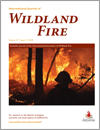
International Journal of Wildland Fire
Volume 27 Number 2 2018
WF17109Sleep in wildland firefighters: what do we know and why does it matter?
This paper reviews firefighters’ sleep during wildfire operations, the operational and environmental factors that impact on sleep, and how sleep affects health and safety. For fire agencies to support firefighting personnel, strategies are needed to improve and manage firefighters’ sleep, and reduce any adverse impacts on firefighters’ work.
WF17109 Abstract | WF17109 Full Text | WF17109PDF (364 KB) Open Access Article
WF17114How do weather and terrain contribute to firefighter entrapments in Australia?
Firefighters are occasionally entrapped by wildfires. This paper presents an analysis of incidents in Australia over the last 40 years, and reveals the main contributing factors to those entrapments. The effect of a wind change on fire spread direction was found to be the principal cause of fatal fire entrapments.
WF17030A comparison of the US National Fire Danger Rating System (NFDRS) with recorded fire occurrence and final fire size
An analysis of the National Fire Danger Rating System for the conterminous US (2006–13). Fire danger indices are correlated with measures of fire activity in order to identify spatial patterns and discrepancies across the US and identify different aspects of wildfire activity along several fire danger spectrums.
WF17148Post-fire surface fuel dynamics in California forests across three burn severity classes
This study provides information on how post-fire surface fuel loadings change within the first 9 years after forest wildfires in dry conifer and hardwood forests of California. Differences in post-fire surface fuel dynamics among fire severity classes – low, moderate and high – are identified.
WF17095Soil organic layer combustion in boreal black spruce and jack pine stands of the Northwest Territories, Canada
In this study, we assess soil organic layer (SOL) combustion in the Taiga Plains and Taiga Shield ecozones of the Northwest Territories, Canada, within the unprecedentedly large area burned by fires in 2014. We provide models and calibrations that should allow future research to more accurately estimate SOL burn depth in black spruce and jack pine boreal forests.
WF17107A method for extensive spatiotemporal assessment of soil temperatures during an experimental fire using distributed temperature sensing in optical fibre
This proof-of-concept experiment uses distributed temperature sensing (DTS) to measure soil temperatures during a managed fire. Using off-the-shelf 242-μm diameter fibre, we were able to collect temperature data every 20 s over a 5.5-h period at 1243 locations along 316 m length of fibre with a spatial resolution of 60 cm.



